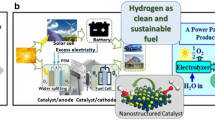Abstract
The strategy of paired electrochemical synthesis for the production of organic chemicals, in which the reactions at both the anode and cathode simultaneously contribute to the formation of the final product(s), could result in as much as a 50% reduction in energy consumption as compared to conventional electro-organic syntheses. In order to evaluate this hypothesis the electrochemical oxidation of glucose to gluconic acid and the reduction of glucose to sorbitol were paired in undivided flow-through parallel plate and packed bed cells.
To date, the optimum electrode materials and operating conditions for the paired synthesis are: an amalgamated zinc cathode, a graphite anode, an initial glucose concentration of 0.8 mol dm−3, a 0.8 mol dm−3 NaBr supporting electrolyte, an electrolyte flow rate of 0.81 min−1 and an electrolyte pH of 7. Under these conditions the current efficiencies for sorbitol and gluconic acid were 26% and 68%, respectively at 0.25 F mole−1. Current losses are believed to be due to hydrogen evolution and the reduction ofδ-gluconolactone (an intermediate in the formation of gluconic acid) to glucose.
Similar content being viewed by others
References
M. T. Sanders and R. A. Hales,Trans. Electrochem. Soc. 96 (1949) 241.
M. Fedoronko,Adv. Carbohydr. Chem. Biochem. 29 (1947) 107.
A. Bin Kassim, PhD Thesis, University of Salford, England (1979).
H. Chum and R. A. Osteryoung, ‘Survey of the Electrochemistry of Some Biomass-Derived Compounds’, SERI Report No. TR 332417 (1981).
S. M. Cantor and Q. P. Peniston,J. Amer. Chem. Soc. 62 (1940) 2113.
J. M. Los, L. B. Simpson and K. Wiesner,ibid. 75 (1953) 6346.
Idem, ibid. 78 (1956) 1564.
H. J. Creighton,Trans. Electrochem. Soc. 75 (1939) 289.
M. L. Wolfrom, K. Konigsberg, F. B. Moody and R. M. Goepp, Jr,J. Amer. Chem. Soc. 68 (1946) 122, 578.
E. A. Parker and S. Swann, Jr,Trans. Electrochem. Soc. 92 (1947) 343.
N. G. Belenkaya and N. A. Belozersky,Zh. Obshch. Khim. 19 (1949) 1664.
R. A. Hales, US Patent No. 2 300 218 (1942).
A. Bin Kassim, C. L. Rice and A. T. Kuhn,J. Appl. Electrochem. 11 (1981) 261.
Idem, 77 (1981) 683.
H. S. Isbell and H. L. Frush,J. Res. Natl. Bur. Stand. 6 (1931) 1145.
H. S. Isbell, H. L. Frush and F. J. Bates,ibid. 8 (1932) 571.
C. G. Fink and D. B. Summers,Trans. Electrochem. Soc. 74 (1938) 625.
M. Ya. Fioshin and I. A. Avrutskaya,J. Appl. Chem. USSR 42 (1969) 2153, 2337.
F. Beck,Angew. Chem. Int. Ed. Eng. 11 (1972) 760.
Y. Pocker and E. Green,J. Amer. Chem. Soc. 95 (1973) 113.
Author information
Authors and Affiliations
Rights and permissions
About this article
Cite this article
Pintauro, P.N., Johnson, D.K., Park, K. et al. The paired electrochemical synthesis of sorbitol and gluconic acid in undivided flow cells. I. J Appl Electrochem 14, 209–220 (1984). https://doi.org/10.1007/BF00618739
Received:
Issue Date:
DOI: https://doi.org/10.1007/BF00618739




